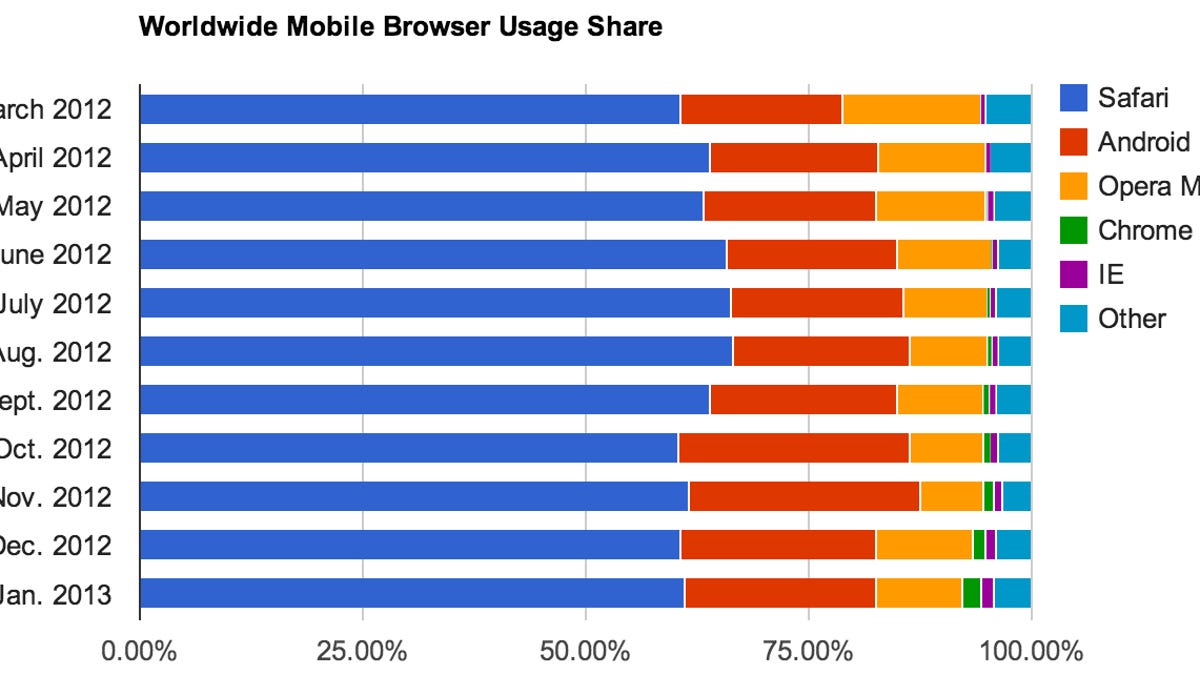Chrome, IE, Silk pry open mobile-browsing market
Newer arrivals on smartphones and tablets have only a small part of the market, but consider that a foot in the door.

New mobile browsers including Google's Chrome, Microsoft's IE, and Amazon's Silk are gaining a foothold in a market that's growing faster than traditional browsing on personal computers.
The mobile browsing market has long been dominated by three products. Apple's Safari has long held the top spot in usage share measurements by Net Applications, with second place going to Google's unbranded Android browser after it surpassed Opera Mini last year.
Safari had 61.0 percent, the Android browser 21.5 percent, and Opera Mini 9.8 percent of usage in January, measurements released today show.
But new contenders are starting to appear now.
The most assured of success is Chrome, which pushed aside BlackBerry OS's browser last November for fourth place. Chrome works on Android 4.0, aka Ice Cream Sandwich, or 4.1 and 4.2, aka Jelly Bean, and now ships with newer Android devices.
Chrome rose from 1.5 percent of use in December to 2.0 percent in January, Net Applications said.
The next to bump BlackBerry down a peg is Microsoft's Internet Explorer, which rose from 1.2 percent to 1.3 percent to claim fifth place in January.
The BlackBerry browser -- which could get a boost if the brand-new BlackBerry 10 OS and its first two phones, the Q10 and Z10 catch on -- slipped down to 1.2 percent of browser usage in January.
That's still ahead of Amazon's Silk, at 0.8 percent, or Opera Mobile, at 0.6 percent. And it's far ahead of Mozilla's Firefox version for Android, which didn't even cross the 0.05 percent threshold.
Mobile browsing is on the increase, rising to an all-time high of 11.8 percent of total browsing in January, according to Net Applications.
On PCs, the browser usage share remained relatively stable.
IE remained the leader with 55.1 percent of the market, and Firefox at 19.9 percent kept its edge over Chrome at 17.5 percent. Safari and Opera stayed level at 5.2 percent and 1.8 percent, respectively.
Net Applications bases its usage data on activity logged on a collection of more than 40,000 Web sites with more than 160 million visits each month. It attempts to weight the data to account for differences in its collection of sites and overall global Internet usage. It also logs only the first Web site visit by a user on each day, in an attempt to measure what people are using rather than how much they use it.
A rival measurement service, StatCounter, bases its measurements on clicks only and doesn't attempt any geographic weighting. It shows different winners and losers, with Chrome in the lead at 36.5 percent, IE next with 30.7 percent, and Firefox in third place with 21.4 percent.

